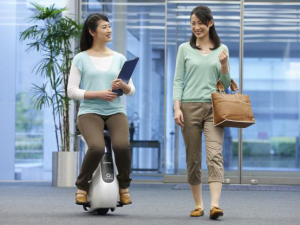06 Oct Everything Dental Blog October 2017
In the future will cars be more ubiquitous or will there be less of them?
There will be a major shift in car manufacturing over the next five to ten years as millennials age. Until we legislate how to regulate driver-less cars, companies like Uber and Lyft will continue to grow in popularity and will likely add services to their mix. As people migrate to the cities, we will experience more gridlock and jockeying for public parking spaces. These forces and the need to ease congestion may lead to changes in our fascination and love for the automobile.
The movement towards healthier emission standards will accelerate the growth of ridesharing and funding for a cleaner, safer and more modern transportation system. National infrastructure programs of the future are expected to include high-speed rail systems and strategies for accommodating electric cars (charging stations at existing gas stations). Before long, we will integrate rider-less cars to less populated communities and controlled or planned environments. We will also raise MPG minimums and emission standards. In addition, urban planners and contractors will design and modify environments to accommodate a new crop of vehicles and transportation devices. Robots with cargo space like Gita will follow us like R2D2 as we walk, run or roll along on our Uni-Cub.

Gita from Piaggio

Uni-Cub from Honda
Another factor is cost. The ‘weekend’ and occasional driver will realize that a car mortgage is not worth it anymore. Instead, they will purchase a local daily, weekly or monthly pass from Uber or Lyft. In time, we’ll see Uber or Lyft introduce national and unlimited rider passes for business people. That’s when companies that provide vehicles or reimburse employees for auto insurance and parking garage rent, in metropolitan areas, will join the sharing economy.
While gas prices are very low today, almost 25% of young adults, just don’t care. They don’t care because they don’t own a car and they don’t drive. According to a study from the University of Michigan, “the percentage of young adults and first-time drivers, has decreased significantly over the past few decades. The percentages of 20 to 24 -year-olds who had licenses in 1983, 2008, 2011 and 2014 were 91.8%, 82%, 79.7%, and 76.7%, respectively. Almost twenty-five percent of these young adults don’t even know how to drive”.
Some of the reasons why the automobile has lost favor with the American youth are…
- Cost of ownership
- Parents have become chauffeurs
- Bike riding is in vogue (popular and healthy)
- The popularity of Uber and Lyft
- Societal acceptance -years ago, parents didn’t allow teens of opposite sex to hang out in the house alone without supervision. That’s why kids from my era hit the streets (we hung out in cars). Today, the average teens bedroom is a theater, video arcade, study hall and virtual vacation destination, so why leave the house?
- Drinking and driving is socially unacceptable behavior with severe penalties and possible incarceration
Let’s imagine cities with less cars. Parking garages would be transformed into apartments and office space. Less parked cars would widen the streets and curbs resulting in more space for pedestrians and bike riders. Fewer gas and service stations would enhance the landscape and create open spaces for businesses and residential construction. Ultimately, this will result in less fumes, less noise and a safer and cleaner city.
As these events unfold, will there will be fewer automobile manufacturers and supporting businesses? Will those businesses transform their manufacturing and sales operations into new markets and industries or will they decline and eventually fail? Hundreds of thousands of people are employed in the auto industry. It seems like every business and industry is being disrupted by some form of technology or by some entrepreneurial visionary. I have written several blogs about unskilled labor and my concern about their livelihood. Many people will lose their job to a computer, robot or software application. I believe skilled labor is at risk too, particularly in the automotive, financial, B to B and retail sectors.
So why is a dental guy writing about automobiles?
It’s simple. I am a parent of two millennials and I’m concerned about the world they and my grandchildren (when I have them) will inherit. Another reason this trend struck a nerve with me is because my previous career was in the automotive aftermarket. From 1981 through 1991, I managed the distribution of (OE) original equipment, replacements parts, safety products, chemical additives and remanufactured automotive components to the NY/NJ/CT automotive sector and municipalities.
It’s ironic that a man who grew up in an era when things got repaired, not replaced would be so interested in technology and change. When I was a kid, if something didn’t last twenty years or more, you would say the manufacturer imposed planned obsolescence on the equipment. Now we replace things because the newer model has a feature or functionality that we can’t live without? I remember listening to Ralph Nader at a N.Y.P.I.R.G (New York Public Interest Group) meeting in 1980/81. He claimed that manufacturers purposely slow technological advancements to secure long and fruitful markets for themselves.
Think about this. Prior to the Japanese auto invasion taking root in the seventies, the Big Three automakers General Motors (Cadillac, Chevrolet, Oldsmobile, Pontiac, and Buick), Ford (Lincoln, Mercury) and Chrysler (Dodge) enjoyed a 90% + market share of the car business in North America. The Big Three marketed different vehicles that shared, in many cases, the same engine and undercarriage based on the size category of the vehicle (compact, mid-size, full-size). In other words, if you purchased a Buick Regal, it was pretty much the same car as a Buick Century (economy version). The difference was in the options; emblem, engine HP, amenities, color choices, and warranty. Another example was the Dodge Dart and Plymouth Valiant. It was basically the same car but the Dart was available as a two-door coupe. Over time reduced EPA emission standards and higher MPG regulations along with the Japanese and European invasion, altered the auto landscape. Below is a picture of a 1970 Datsun 240Z – a very popular car when I was in 6th grade. At that time, the (NMC) Nissan Motor Company and Toyota were making small but noticeable, inroads into the U.S. market. They loaded their cars with amenities like AC, power windows, power side-view windows, an AM/FM stereo system (with front and rear speakers) and a rear defogger. By bundling these features as standard equipment they disrupted the new car market and gained valuable market share from the Big Three.

We all know that change is happening at a rapid pace due to digitization, miniaturization and telecommunication advancements. Our world changed when that phone became a smartphone and everyone had a computer in their pocket.
Change is everywhere and we must pay attention to the trends and movements in our industry and around us. We must be proactive and mindful about our business. Regardless of your job, it’s important to be well rounded and knowledgeable about global, national and industry news. If you don’t have a plan, you should make one now. It doesn’t matter if you are the employee, employer or entrepreneur. Sitting on the sidelines is no longer neutral and acceptable. Change is happening so quickly, that we risk everything if we fail to evolve.
Here is a caveat for us dental folk. Dentistry will continue to grow as we address access to care issues and as the public becomes educated regarding the oral-systemic link. No device, software program or robot can provide personalized comprehensive dental care. Our business may be changing but it’s not in jeopardy – We have a bright future!
To my clients and friends who are tormented by an abundance of challenges and decisions. Consider this: trial and error mistakes are correctable. Inaction can create too big a spread that would require too much investment for you to recover. We must maintain a positive trajectory and we must operate at a winning pace to stay ahead. The ability to bounce back when you fall behind is costly and the chances for success diminish over time.
Dentists are at the crossroads. The marketplace is digitizing and many dental facilities are embracing 3D imaging and digital impressioning or CadCam. Many dentists and dental groups are investing in Practice Management Consulting to accelerate their operational capability. In addition to the technology and practice management piece, we are seeing all sectors investing in marketing, social media and public relations campaigns.
Here is a quick way to evaluate purchases, ideas and investment strategies.
Will this purchase –
- Improve my dentistry?
- Speed up my operative and restorative dentistry?
- Make my life easier?
- Enhance my menu of services?
- Create a better patient experience?
- Make my business more effective and more profitable?
If you answered yes to all or most of the questions above, then you have vetted the idea successfully. Now you must act.
We are all participants, like it or not, in a technological revolution. Our success is dependent on us being well informed, engaged and decisive about our business. This goes for the automotive worker whose long-term career security is uncertain and the dentist who has the burden to keep up.


